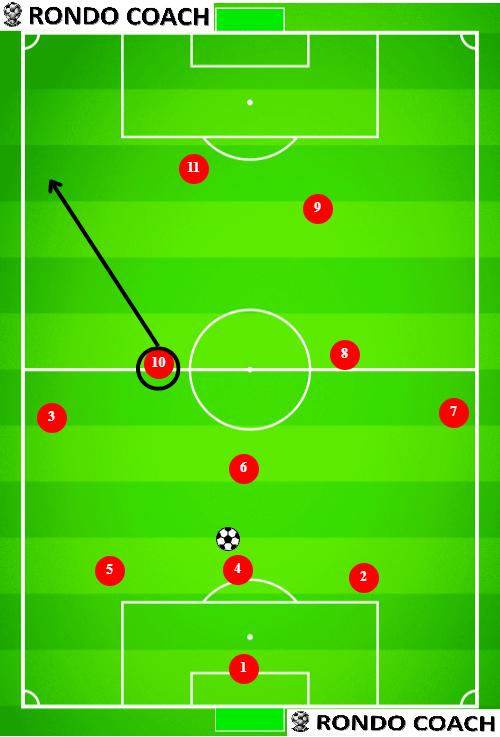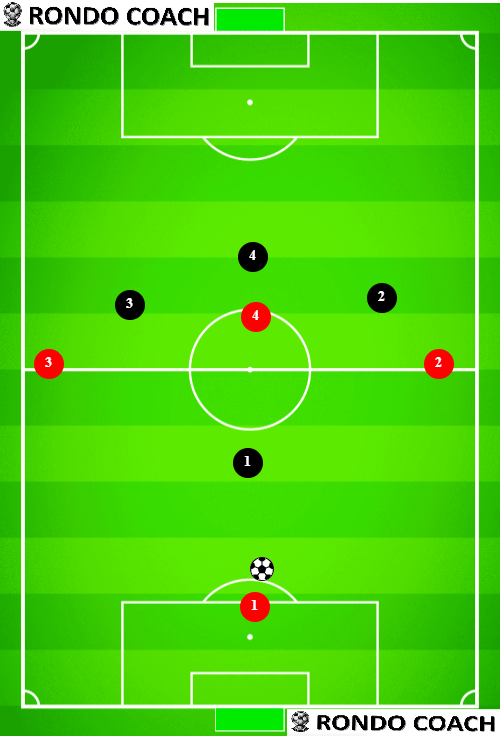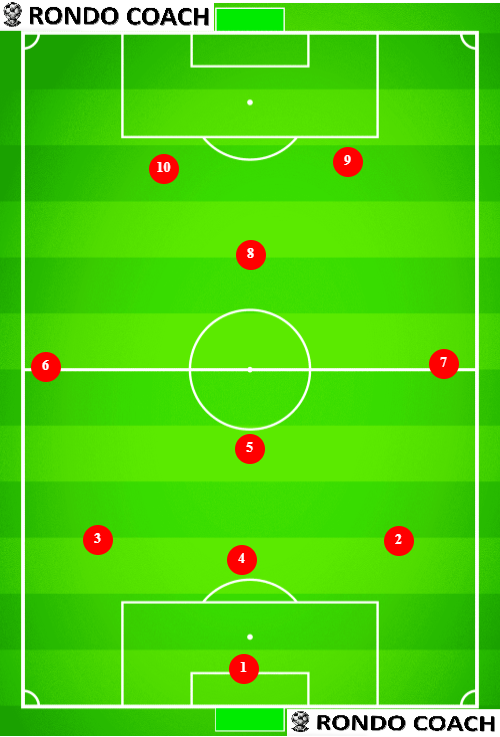What is Mezzala in Soccer? [Complete Tactical Guide]
Central midfielders are the most versatile players on the pitch. However, even they have some advantages that they can express, especially in attack. Being able to wear many hats, a mezzala needs to find the right time to drift to the wing and create an overload. Often cooperating with the wing-back and the winger, can truly create confusion for the opponents. If the three players on the wing have the pace to do overlapping and underlapping runs, the defense can have their hands full. Furthermore, if they end up dragging more defenders, then a quick switch to the other side or a cross can create a numerical advantage in a very dangerous area. We have seen some fantastic players, such as Iniesta and Odegaard, really owning this role. Let’s look at what is needed to excel in it and the systems in which it makes sense to use it.
What is the Role of Mezzala in Soccer?
Mezzala is the role of a central midfielder that occupies a wide forward area of the pitch. The main purpose is to provide support to the team by pushing high in the winger area when the team is in possession. Mezzalas are often used to provide support to the wingers and wing-backs. This is especially true if some of them play in inverted roles. While attacking patiently and switching the ball from one flank to the other, a mezzala can create a numerical advantage. Also, they can create quality or dynamic superiority is hard to defend against. The players need to have good technical qualities, but also tactical knowledge to time their runs. That will avoid being caught off possession, and allow the opponents to progress in a counter-attack.
Formations for a Mezzala
There are lots of different ways to use mezzalas. Because it’s not easy to coach it, you will rarely see it in youth soccer teams and their tactics, even when you see players randomly drifting into it. The most typical ones are the 4-3-3 formations, which have been seen a lot by Guardiola and his disciples, Arteta and Xavi. We see that technically gifted and incredibly creative players with vision can make a difference in the wide areas, not just through the middle. In fact, they can contribute more when the opponents cannot predict their passes while positioned in the half-spaces, as it opens too many channels. Furthermore, with the rise of inverted fullback, the wingers do need support, especially if they are outnumbered.
Other common formations that support the mezzala role are 3-4-3 or even 3-5-2. As you can notice, in all cases the importance is to have many of players in the middle, so that the abandoned space is not easily targeted. If the players are dynamic that is easier, as they cover lots of ground. However, the positional awareness of the teammates to occupy the place in the center of the pitch is vital for the mezzala to have the freedom to help in attack.
4-3-3

In a 4-3-3 formation, the fullbacks can act as traditional fullbacks or as inverted fullbacks when attacking. However, keeping the wingers high and wide can create distance from the fullbacks. Getting the right amount of support for them is often the role of the attacking midfielders who will need to drift. Furthermore, they might need to occupy that area if the winger cuts in or plays as an inverted winger. The 8 and the 10 are fairly balanced in the attacking and defensive duties. Therefore, the moment of attacking the wings is up to them to time it. Similarly, if one of them goes wide, then the other one might need to balance that by coming more central. Either way, it’s not an individual decision that can work without cooperation with the teammates.
3-4-3 Formation

With the 3-4-3 formation heavily concentrated in the middle, it can be hard to break low-block teams. However, that also means that the central midfielders need to have the freedom to bring confusion in the opposition’s defense. If they can drift to the sides and create overloads, that can create opportunities for the wingers. Then strikers push through the half spaces and cut in passes to the middle. Easier said than done. Having versatile central midfielders who can keep possession and exploit these spaces will be of great benefit to the team.
3-5-2

In the 3-5-2 formation the central attacking midfielders can act as carrileros, but also as mezzalas. In fact, in a well-managed system, there can be mismatches. For example, if one of the fullbacks bombs down on the flank, but doesn’t get much support from the striker that stays central, then it is natural for the midfielder to act like a mezzala. On the other flank, maybe the other striker wants to drift and act like a raumdeuter. Well, then we can have a supporting act of a carrilero. It is up to the coach to understand the quality superiority of their team.
Attributes of a Mezzala
As it is a role that can change over the course of the game, it is often flexible in the requirements. However, the key is to have experienced, versatile players to complement the others on the team. First of all, their positioning and timing have to be excellent, otherwise, it creates more issues than it solves. Secondly, their decisions must be correct or it will leave the team exposed. Finally, their physical attributes will require them to quickly cover a fair amount of ground, as they will essentially play in somewhat distant areas in possession vs. in defense.
Attacking traits
The main attacking attributes of a mezzala are proficient first touch, passing, and vision. The first touch is important for any player that receives passes in the opposition third, especially with high pressure and high pace. This goes together with dribbling and flair, mezzalas are in positions to produce something out of nothing if there is an opportunity. When the player is placed in a position to play 1v1 near the box, they have to quickly control the ball and take a chance to score or assist. If that capability is not there, then there is no threat to the opponents and the effectiveness is much smaller.
If the numerical advantage is lost, then it’s up to the player to have the vision and passing ability to move the ball to another area. This patient approach might frustrate the team, but it will be even more annoying to the opponents. However, that assumes that the player can identify the opportunities and take them, but also make a good decision when there is no opportunity and move the ball quickly.
Defending skills
Obviously, a mezzala shines when the team has possession. However, the role is not of a poacher, so it has some defensive duties. The most important feature is to recognize when it needs to transition into them. The anticipation ability is key for the role. If the player can see a move or two ahead and repositions themselves (off-the-ball skill) to account for more aggressive offensive opportunities or more cautious defensive or even counter-pressing situations, then we have a quality mezzala in the squad. The only way a player can do this effectively is if they possess a high work rate and amazing stamina. Putting these together in one player is what makes it really challenging.
Famous mezzalas
As this is a very specific role with many challenges, there are not many players who have played their entire careers as a mezzala, but there are some who have become famous in the soccer world while excelling in it. They often played as central midfielder, a winger, or a creative playmaker in some systems. However, when there was a need, they stepped up to the challenge.
The most obvious one today is Martin Odegaard in Arsenal. He plays with Bukayo Saka on the wing, often inverted, in a 4-3-3 formation. Similarly, Mason Mount (and others) were acting as mezzalas in the 3-5-2 Chelsea team that won the Champions League in 2021. However, if you are looking at a masterclass, look no further than Iniesta. He was not a classic 10 or 8 (as his jersey number suggested). He was flawless in finding the wide areas to exploit at the right time. Clearly, his technical skills resulted in high effectiveness when playing as the mezzala in the legendary Barcelona teams for over a decade.
Conclusion
There it is – a full guide of mezzala in soccer. We covered what the role is, which formations to use it in, and the characteristics of it. The details of the role are so fascinating that they cannot be explained in a brief definition, so we decided to make a guide out of it. Finally, we looked at famous players who have played the role at the highest level. They made us think of the balance that our teams need to have in order to win games and maintain possession.










































